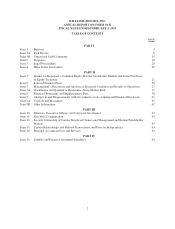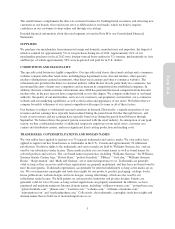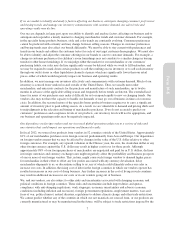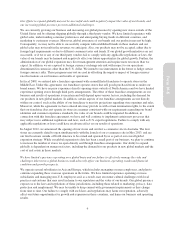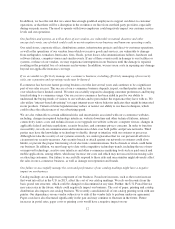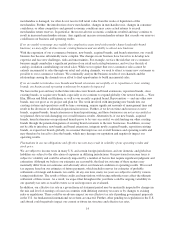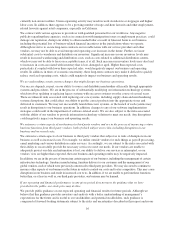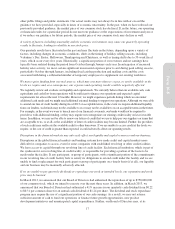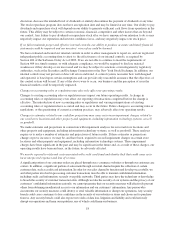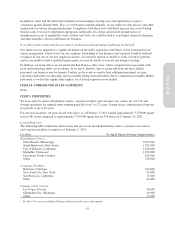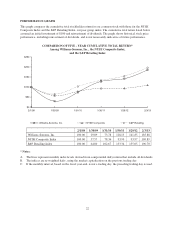Pottery Barn 2012 Annual Report Download - page 26
Download and view the complete annual report
Please find page 26 of the 2012 Pottery Barn annual report below. You can navigate through the pages in the report by either clicking on the pages listed below, or by using the keyword search tool below to find specific information within the annual report.In addition, we face the risk that we cannot hire enough qualified employees to support our direct-to-customer
operations, or that there will be a disruption in the workforce we hire from our third party providers, especially
during our peak season. The need to operate with fewer employees could negatively impact our customer service
levels and our operations.
Our facilities and systems, as well as those of our vendors, are vulnerable to natural disasters and other
unexpected events, any of which could result in an interruption in our business and harm our operating results.
Our retail stores, corporate offices, distribution centers, infrastructure projects and direct-to-customer operations,
as well as the operations of our vendors from which we receive goods and services, are vulnerable to damage
from earthquakes, tornadoes, hurricanes, fires, floods, power losses, telecommunications failures, hardware and
software failures, computer viruses and similar events. If any of these events result in damage to our facilities or
systems, or those of our vendors, we may experience interruptions in our business until the damage is repaired,
resulting in the potential loss of customers and revenues. In addition, we may incur costs in repairing any damage
beyond our applicable insurance coverage.
If we are unable to effectively manage our e-commerce business, including effectively managing cybersecurity
risks, our reputation and operating results may be harmed.
E-commerce has been our fastest growing business over the last several years and continues to be a significant
part of our sales success. The success of our e-commerce business depends, in part, on third parties and factors
over which we have limited control. We must successfully respond to changing consumer preferences and buying
trends relating to e-commerce usage. Our success in e-commerce has been aided in part by our ability to
understand the buying trends of visitors to our websites and to personalize the experience they have with us. We
also utilize “interest-based advertising” to target internet users whose behavior indicates they might be interested
in our products. Current or future legislation may reduce or restrict our ability to use these techniques, which
could reduce the effectiveness of our advertising spend.
We are also vulnerable to certain additional risks and uncertainties associated with our e-commerce websites,
including: changes in required technology interfaces; website downtime and other technical failures; internet
connectivity issues; costs and technical issues as we upgrade our website software; computer viruses; changes in
applicable federal and state regulations; security breaches; and consumer privacy concerns. In order to function
successfully, we rely on communication and transmission of data over both public and private networks. Third
parties may have the knowledge or technology to disable, disrupt or interfere with our systems or processes.
Although we take the security of our systems seriously, we cannot guarantee that we can prevent all efforts to
circumvent our security measures. Any security breach or attack against our networks or systems could slow,
hinder, or prevent the proper functioning of our electronic communications. Such a breach or attack could harm
our business. In addition, we must keep up to date with competitive technology trends, including the use of new
or improved technology, creative user interfaces and other e-commerce marketing tools such as paid search and
mobile applications, among others, which may increase our costs and which may not succeed in increasing sales
or attracting customers. Our failure to successfully respond to these risks and uncertainties might adversely affect
the sales in our e-commerce business, as well as damage our reputation and brands.
Our failure to successfully manage the costs and performance of our catalog mailings might have a negative
impact on our business.
Catalog mailings are an important component of our business. Postal rate increases, such as the recent increase
that went into effect in the U.S. in 2013, affect the cost of our catalog mailings. We rely on discounts from the
basic postal rate structure, which could be changed or discontinued at any time. Further, the U.S. Postal Service
may raise rates in the future, which could negatively impact our business. The cost of paper, printing and catalog
distribution also impacts our catalog business. We recently consolidated all of our catalog printing work with one
printer. Our dependence on one vendor subjects us to risks if the vendor fails to perform under our agreement.
Paper costs have also fluctuated significantly in the past and may continue to fluctuate in the future. Future
increases in postal rates, paper costs or printing costs would have a negative impact on our
12


